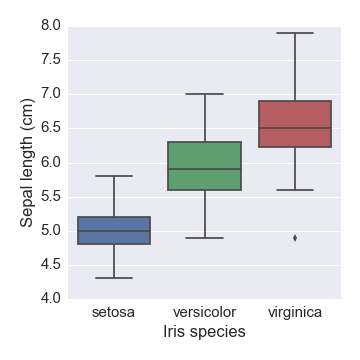23. Quiz: Shape and Outliers (Comparing Distributions)
Image Summary
In the below image, we have three box-plots. Each box-plot is for a different Iris flower: setosa, versicolor, or virginica. On the y-axis, we are given the sepal length. Notice that virginica has an outlier towards the bottom of the plot. Therefore, the minimum is not given by the bottom line here; rather, it is provided by this point.

Quick Refresher: The measures of center and spread we can determine from a Box Plot are as follows. Let's use Setosa for these examples.
Median is the center line inside the box and is 5
IQR is space between the first and third quartile which are the edges of the box. They are about 4.8 for the first quartile and 5.2 for the third
QUIZ QUESTION::
Match the appropriate Iris type to the statement(s) that are true for its Sepal Length.
ANSWER CHOICES:
|
Sepal Length |
Iris Type |
|---|---|
The largest Range |
|
The smallest Interquartile Range |
|
Median is approximately 5 |
|
Third quartile is approximately 6.3 |
|
Approximately Symmetric |
|
The largest sepals on average. |
SOLUTION:
|
Sepal Length |
Iris Type |
|---|---|
|
The largest Range |
|
|
The largest sepals on average. |
|
|
Third quartile is approximately 6.3 |
|
|
The smallest Interquartile Range |
|
|
Median is approximately 5 |
|
|
The smallest Interquartile Range |
|
|
Median is approximately 5 |
|
|
The largest Range |
|
|
The largest sepals on average. |
|
|
Approximately Symmetric |

Box Plot
SOLUTION:
- More than 75% of the virginica flowers have a larger sepal length than the largest setosa flower.
- More than 50% of setosa flowers have larger sepal length than the shortest versicolor flower.